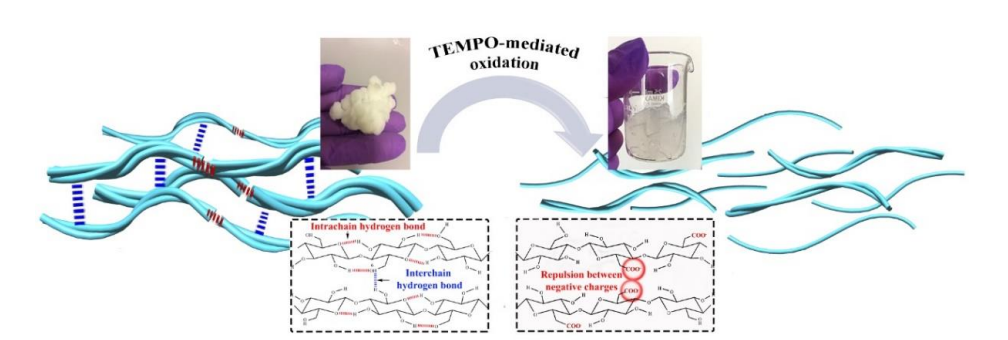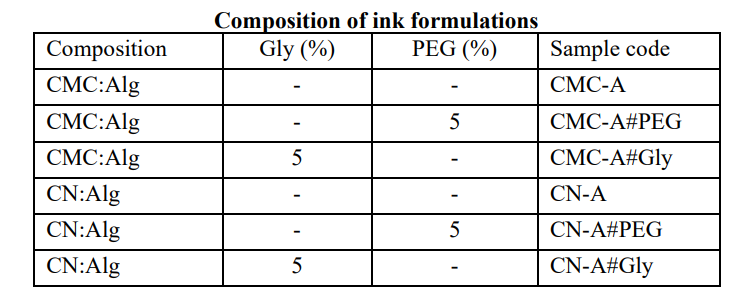Researchers from Romania have recently delved further into materials associated with 3D printing, outlining their findings in ‘Polysaccharide-Based 3D Printing Inks Supplemented with Additives.’ In this study, they combined a variety of different polysaccharides to improve 3D printing inks.
“A wide range of materials have shown potential in 3D printing but modeling these materials into self-supporting items with tunable mechanical properties, degradation, and suitable rheological response is still an issue,” explain the authors, as they introduce us to the process of creating new inks, beginning with refining wettability.
Wetting agents—or humectants—also reduce the contact angle between bioink and the printer nozzle, as well as decreasing the chances for drying or crusting.
Typical humectants include:
- Polyethylene glycol (PEG)
- Glycerol (Gly)
- Sorbitol
- Urea
In this study, the researchers created a ‘promising ink formulation’ based on CMC/Alg and CN/Alg, using wetting agents derived from both small and low-molecular weight polymers.
“Printing inks were formulated by using two precursor mixtures, CMC:Alg and CN:Alg in 1:1 mass ratio. For the first mentioned formulations, a solution of 4% CMC was prepared in distilled water and the corresponding amount of Alg was added under gentle stirring,” explained the researchers. “The latter formulations were obtained by directly dissolving Alg within CN suspension.”
Inks were printed using the 3D Discovery bioprinter from RegenHU. 3D printing experiments were performed, along with bioprinting of hydrogel scaffolds. BioCADTM software was used to create the G-code for the 3D constructs used in the study.
While Alg is not the best option for 3D direct writing on its own, CMC and CN ‘enhanced’ viscosity, better cross-linking occurred, and the -OH groups present offered a positive effect over solubility, and both rheological and mechanical behavior.

Schematic representation of the fibrillary organization of cellulose
before and after oxidation process
“Both cellulose types used herein, CMC and CN, differ greatly with respect to chemical and morphological features and yet both present favorable printing behavior,” stated the researchers.
Overall, rheological evaluation by the researchers stated that CMS compositions possessed low viscosity, flowing immediately upon stress. High-viscosity drops required ‘adequate external forces’ to engage the printing process.
“Loading an additional compound (such as PEG and glycerol) suggested the improvement of the wetting properties leading to slightly lower filament diameters relative to the corresponding reference composition,” stated the researchers.
“Considering the printing performance with respect to the predesigned architecture it can be concluded that a successful 3D printing was achieved using glycerol in the ink composition. Therefore, the fabrication of 3D scaffolds using a cellulosic material combined with alginate and a suitable additive provide accurate geometries but also guide the applications of the obtained hybrid hydrogels in the biomedical field.”
Researchers around the world are creating bioinks and hydrogels in labs, using materials meant to encourage tissue engineering of the liver, corneas, and more. What do you think of this news? Let us know your thoughts! Join the discussion of this and other 3D printing topics at 3DPrintBoard.com.
[Source / Images: ‘Polysaccharide-Based 3D Printing Inks Supplemented with Additives’]Subscribe to Our Email Newsletter
Stay up-to-date on all the latest news from the 3D printing industry and receive information and offers from third party vendors.
You May Also Like
3D Printing Unpeeled: New Arkema Material for HP, Saddle and Macro MEMS
A new Arkema material for MJF is said to reduce costs per part by up to 25% and have an 85% reusability ratio. HP 3D HR PA 12 S has been...
3D Printing News Briefs, January 20, 2024: FDM, LPBF, Underwater 3D Printer, Racing, & More
We’re starting off with a process certification in today’s 3D Printing News Briefs, and then moving on to research about solute trapping, laser powder bed fusion, and then moving on...
3D Printing Webinar and Event Roundup: December 3, 2023
We’ve got plenty of events and webinars coming up for you this week! Quickparts is having a Manufacturing Roadshow, America Makes is holding a Member Town Hall, Stratafest makes two...
Formnext 2023 Day Three: Slam Dunk
I’m high—high on trade show. I’ve met numerous new faces and reconnected with old friends, creating an absolutely wonderful atmosphere. The excitement is palpable over several emerging developments. The high...

































